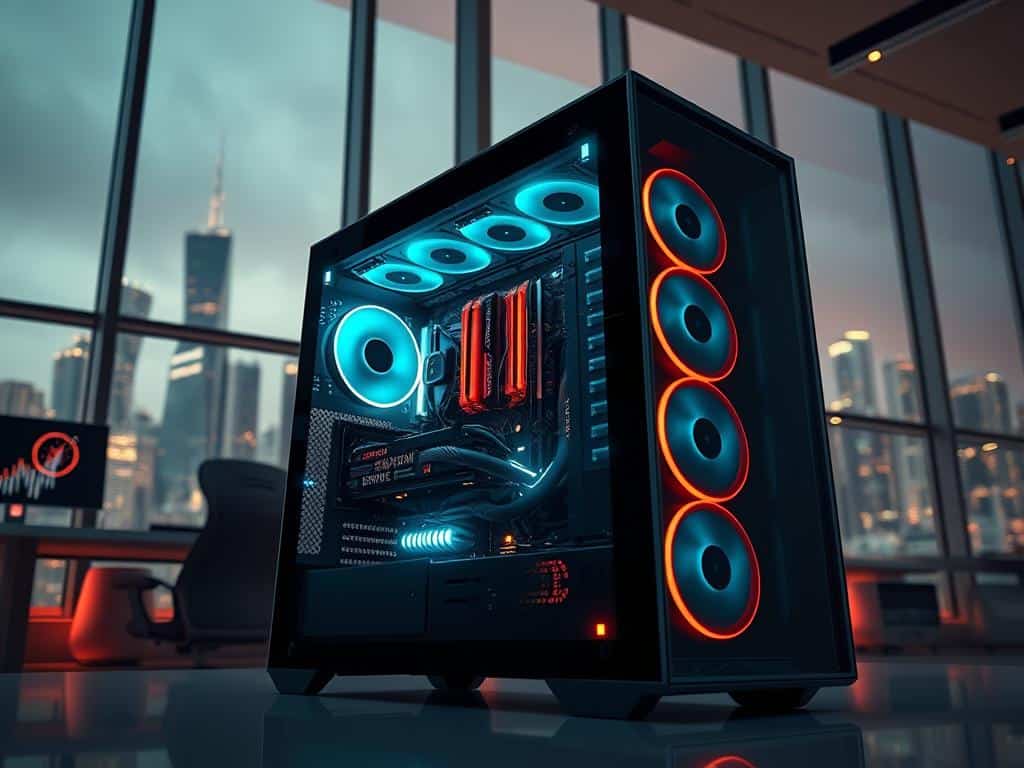Did you know you can build a top-notch gaming PC for just $1,000? With the cost of parts always changing, smart builders can make setups that beat pricey prebuilt ones. This guide will walk you through building your own gaming PC, focusing on saving money. We’ll cover everything from picking the best CPU to choosing the right storage, all without spending too much.
Key Takeaways
- You can create a high-performance gaming PC for under $1,000.
- Choosing cost-effective components allows for optimal performance.
- Building your own PC offers substantial savings compared to prebuilt systems.
- Understanding key components like CPUs and GPUs is essential for your build.
- Future-proofing your gaming PC ensures longevity and performance.
Introduction to Building a Gaming PC
Building a gaming PC is now easier than ever. Thanks to new tech and lots of online guides, anyone can do it. Gone are the days when you needed to be a tech expert. Today, you can pick the parts that fit your gaming style.
Many people prefer prebuilt PCs for their ease. But, a DIY PC has its own perks. It lets you upgrade later and ensures top-notch parts. To start, you need to know the basics of what makes a gaming PC tick.
Let’s dive into the essential parts of a gaming PC. We’re talking about the CPU, GPU, RAM, and storage. Knowing these will help make sure your PC is ready for fast-paced games.
Key Components for Your Gaming PC Build
Building a PC for gaming starts with knowing the key parts. Choosing the right CPU, GPU, memory, and storage is key. These choices boost performance and make your PC last longer.
Choosing the Right CPU
The CPU is the heart of your gaming PC. I love the AMD Ryzen 5 7600 for its great performance and price. It has six cores and twelve threads, running at 3.8GHz and reaching 5.1GHz for better gaming.
Make sure the CPU fits your motherboard. This ensures all parts work well together.
Finding the Best GPU
The GPU is essential for top gaming. I recommend the XFX Speedster QICK 319 Radeon RX 7700 XT. It has 12GB of VRAM and supports FreeSync and FidelityFX for smooth gaming.
A good GPU is key for fast gaming at 1080p.
Memory and Storage Considerations
Memory and storage affect your gaming speed. Aim for at least 16GB of RAM, but 32GB is better for new games. An NVMe SSD, like Kingston’s NV2 1TB SSD, cuts load times by six times.
Choosing the right memory and storage is the base of a great gaming PC. It supports your project and stays within budget.
Building the Ultimate Gaming PC for Under $1000
Building your gaming PC is exciting and rewarding. It needs careful planning and following specific steps. I’ll show you how to start with the case and motherboard, then install the CPU, cooler, RAM, and GPU. With the right attention and safety, you’ll have a great PC.
This guide will walk you through the assembly process. It includes tips for a smooth build and common mistakes to avoid.
Step-by-Step Guide to Assembling Your PC
Start with the case, making sure it’s clean and has enough room. Install the power supply first, fitting it into its spot. Then, put in the motherboard, aligning it with the case’s standoffs.
Install your CPU and cooler, applying thermal paste if needed. The Cooler Master Hyper 212 Evo is a good choice for cooling. Next, add the RAM sticks, ensuring they click into place.
For the graphics card, the AMD RX 6500 XT is a good pick for its price and performance. Connect all power cables and tidy up the wiring for better airflow. Always use anti-static precautions to avoid damage.
Cost Breakdown of Recommended Components
The total cost for my gaming PC build is about $1,047. This is a great balance of performance and price. The AMD Ryzen 5 7600 CPU costs around $182, and the ASRock B650 PG LIGHTING motherboard is about $120.
The XFX RX 7700 XT GPU is priced at $350, boosting performance. The Zalman T7 ATX case costs $50, and the Thermaltake Toughpower 750W PSU is $110. Watching prices at Newegg and Amazon helps stay within budget. This breakdown shows how to build a powerful gaming PC without spending too much.
Considerations for Performance and Future Upgrades
Building a gaming PC for under $1000 requires careful thought. I aim for top performance and future-proofing without overspending. This section will explore how to boost my system’s power without breaking the bank.
Balancing Performance with Price
Choosing the right components is key for performance. For gaming, 8GB RAM is a good start, but 16GB or more helps with multitasking. A mid-range GPU like the AMD Radeon™ RX 6600 XT is great for 1080p gaming.
For ultra-high settings and 4K, a high-end GPU like the NVIDIA GeForce RTX™ 3080 Ti is better. Finding the perfect balance in the budget is my challenge.
Making Your Build Future-Proof
Choosing components that support future upgrades is essential. A motherboard that supports new CPUs, like Intel’s 13th-generation i7 or AMD Ryzen™ 7000 series, is a good start. A quality power supply, like the 750W Thermaltake, ensures room for upgrades.
Using SSDs over HDDs boosts performance and cuts loading times. Good cooling, like liquid cooling systems, is also key for overclocked setups. It helps extend my gaming PC’s life.

Conclusion
Building a gaming PC for under $1000 is easy and can handle today’s games well. This guide helps me pick the right parts for my needs, saving money. Many gamers save 20-30% by building their own PCs.
Starting this project takes time, from a few hours to days, based on my experience. Customizing a budget PC lets me meet my specific needs. This is why 75% of DIY builders focus on it. Plus, I learn a lot about computer hardware while building.
Creating a great gaming PC doesn’t have to cost a lot. With a good plan and this guide, I’m ready to build a powerful PC. I hope my tips help others build their PCs without spending too much.



